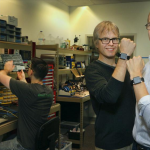One Small Step for a Man: Estimation of Gender, Age and Height from Recordings of One Step by a Single Inertial Sensor
Is it possible to classify gender, age, and height based on gait analysis? Published in the latest Sensors, Qaiser Riaz, Anna Vögele, Björn Krüger, and Andreas Weber explore the possibilities of classifications of soft biometric data in a study entitled “One Small Step for a Man: Estimation of Gender, Age and Height from Recordings of One Step by a Single Inertial Sensor.”
Soft Biometrics is an identification system based on biometric, morphological and anthropometric determinations that can be used to help identify individuals. First explored by Alphonse Bertillon in the 19th century, coloration, height, weight, and gait are some of the physical and behavioral traits that help us automatically recognize people. Unlike traditional biometrics, soft biometrics typically allow recognition from afar using understandable labels and measurements rather than statistical analysis of biological data.
Motion capture and contact force measurements have provided estimation of kinematic properties of living things in previous years. This study analyzed movements of a group of men and women to see if data from a single APDM wearable sensor could reveal information about the moving subject. Results showed that this was indeed possible – the team was able to classify gender, age and height with processed representations of single steps recorded. The team was able to recover soft biometric information with high accuracy consistently over various sensor positions.
The study used a standardized 10-meter straight walk to analyze steps in each subject. The subjects were instructed to walk from a starting point, turn around and walk back to the starting point. “Participants were asked to walk in their natural manner and to repeat the gait task two times, resulting in a 4 × 10-meter walk. Three different types of experiments were performed: (1) walking on a hard surface (concrete floor) with shoes on; (2) walking on a hard surface (concrete floor) with bare feet; and (3) walking on a soft surface (exercise mattress) with bare feet. Data were recorded during three different stages of the training course: (1) at the start of the training (before the 1st session); (2) in the middle of the training (after the 3rd session); and (3) at the end of the training (after the 6th session).”
The team was particularly interested in the inertial measurements of four different body parts: chest, lower back, right wrist, and left ankle. They analyzed data from a variety of metrics including things like step length, duration, and energy of the step, utilizing the triaxial abilities of the sensors to gather data in all planes. The data provided different combinations of metrics that show more or less contribution to the identification of an individual.
In previous studies, gender classifications were made using chest and lower back movement. Coinciding with these studies, the team found that the classification rates were highest for sensors located at the lower back and chest, but still convincingly high when the sensor was attached to the wrist or ankle. This study showed that accelerations associated with wrist and ankle movement alone allow for classification of gender, as well. The team also claimed to be the first to show that classification of height and age groups was possible from non-visual features.
The application of this data makes sense in multiple scenarios. For example, biometrics have been used for online identity checks and tight security gaps. Identification of individuals from a distance is imperative to surveillance infrastructure deployed in today’s society, including the armed forces. Monitoring health or preventing injury such as falls is also a relevant application.
The team hopes to engage in future research where they will try to adopt a model-based estimate of body-part orientation.
For more information regarding APDM wearable sensors, click here.





